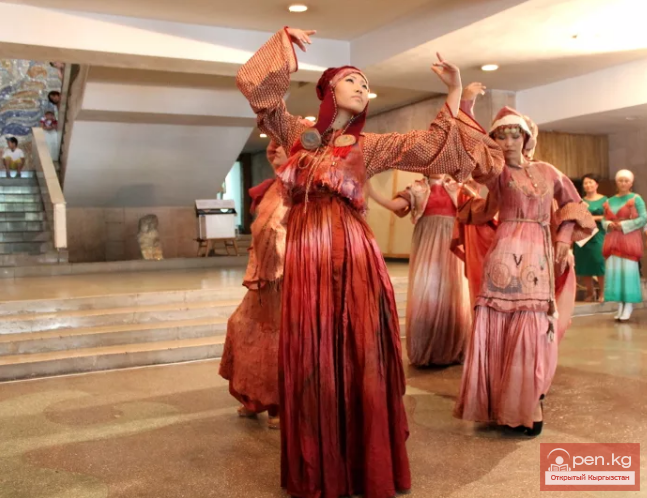Search for Folk Dance
In the folk music of the Kyrgyz, "there are many playful, cheerful songs, dance melodies, humorous and comic images." This dance element is particularly vividly expressed in the art of Kyrgyz instrumental musicians, manaschi, in the mimicry and expressive movements of folk entertainers — kuu-duldar, and in various games.
The names of traditional kyuu, composed by musicians and passed down from generation to generation, allow us to speak about the character of the music being performed. (Solkuldak — elastic, lively, saltanat — lush, solemn.) The reproduction of the rhythm, marked by the musician on the komuz, is often "adorned" by the performer themselves with various gestures and facial expressions that convey the essence of the piece. Yet, despite evidence of the existence of Kyrgyz dances and performances, time has not preserved their complete and complex forms. The prominent Soviet theater scholar N. Elyash rightly notes that "after many centuries of oppression and subjugation, the art of dance among the Kyrgyz has disappeared, just as the numerous dances of Ancient Greece, which Homer, Hesiod, Plato, and Lucian wrote about so eloquently, have vanished."
Only during the Soviet era did folk and professional art receive unprecedented development, leading to the revival of invaluable artistic creativity. It, having acquired new content, opened wide access to spiritual values for the working masses. People themselves became creators of culture. The true flourishing of amateur art was vividly illustrated by city, regional, and republican folk art olympiads, which revealed talented artists from the people. This process was tumultuous and rapid. If the first citywide amateur art competition in Frunze in 1932 had one hundred sixty-five participants, the I All-Kyrgyz Olympiad of Folk Art in 1936 involved about ten thousand participants, with more than a thousand talented singers, storytellers, musicians, and dancers performing in the final concert. Such representative participation of art enthusiasts became possible due to the everyday identification of gifted performers at collective farms, district, city, and nationwide artistic olympiads. At these nationwide showcases of art, Russian, Ukrainian, Uzbek, and Tatar dances, as well as performances from other peoples, were presented. Among them were the first Kyrgyz dances created based on folk games.
It is important to note that in the creation and promotion of folk dances and performances, a special role was played by the recently established Kyrgyz Musical Theater and its masters. The search and experimental work on creating new elements of the Kyrgyz national dance were closely linked to the staging of theatrical compositions, embodying the colors of folklore in the first performances of the Kyrgyz Musical Theater.
This process contained many complexities. "The search for folk dance," said one of the first choreographers of Kyrgyzstan, Nikolai Sergeyevich Kholfin, "style and form presented great difficulty. To grasp them, one had to familiarize oneself with Kyrgyz ornamentation, with the labor processes characteristic of the Kyrgyz way of life, with natural features, the decoration of dwellings, etc. It was here that the material for restoring the dance, for ballet compositions, lay."
It was the labor process, reproducing the making of felt, that became the basis for one of the first Kyrgyz dances.
The performers of the dance "Kiyiz" ("Felt") lightly ran onto the stage, picked up imaginary clumps of wool from the ground, and began to stomp, sprinkle "water," and compact it with sticks. And when the felt was ready, the girls showcased their work to the audience and arranged themselves on the felt in picturesque poses.
The choreographer of the dance "Kiyiz," N. Kholfin, managed to capture the most characteristic movements, steps, poses, and positions of the hands and head used in processing felt, and gave them an organic dance form. The dance became effective, embodying the entire laborious process of felt production. Many movements became elements of the dance: walking on the heels, stepping, arm swings upward with a sharp drop of the wrist downward, as if kneading the felt, turns, bent wrists in front — all of this became the main material for creating the dance. The pattern of the dance, the character of the performance, the entire dance composition were inspired by the talent of folk craftsmen — creators of tushkiyiz, in which ornamental artistic images are specific and close to nature.

The melody of this dance is in the spirit of Kyrgyz folk music. Composers V. Vlasov and V. Fere sensitively captured the intonational features of Kyrgyz folk music and originally transformed it into dance form. The music of the dance "Kiyiz" became not only a tempo-rhythmic framework but also defined the figurative and concrete plasticity, helping to reveal the emotional essence. The simplicity of the dance "Kiyiz," the softness, the plasticity of the "speaking hands" of the performers, the simplicity and life-like authenticity brought it unanimous recognition.
The dance "Kiyiz" — one of the first works of national choreography — is widely spread and has become a truly folk dance.
The Spread of Choreographic Art. The History of Kyrgyz Folk Dance. Part 10

